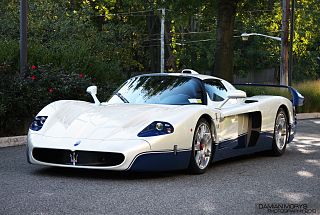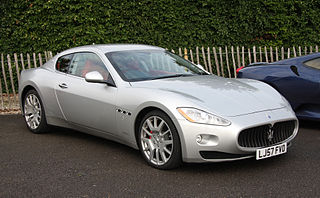
The Ferrari 456 and 456M are front-engine grand tourers which were produced by Ferrari from 1992 to 2003. The 456 was a replacement for the front-engine 412 as the company's V12-powered four seater. The updated 456M, which was the last Ferrari model to use pop-up headlamps, was replaced in 2004 by the 612 Scaglietti.

The Ferrari F430 is a sports car produced by the Italian automobile manufacturer Ferrari from 2004 to 2009 as a successor to the Ferrari 360. The car is an update to the 360 with notable exterior and performance changes. It was unveiled at the 2004 Paris Motor Show. The F430 was succeeded by the 458 which was unveiled on 28 July 2009.

The Dino 308 GT4 and 208 GT4 were mid-engined V8 2+2 cars built by Ferrari. The Dino 308 GT4 was introduced in 1973 and supplemented by the 208 GT4 in 1975. The cars were sold with Dino badging until May 1976, when they received Ferrari badging. The GT4 was replaced by the Mondial 8 in 1980 after a production run of 2,826 308s and 840 208s.

The Ferrari 550 Maranello is a front-engine V12 2-seat grand tourer built by Ferrari from 1996 to 2001. The 550 Maranello marked Ferrari's return to a front-engine, rear-wheel drive layout for its 2-seater 12-cylinder model, 23 years after the 365 GTB/4 Daytona had been replaced by the mid-engined Berlinetta Boxer.

The Ferrari F40 is a mid-engine, rear-wheel drive sports car engineered by Nicola Materazzi with styling by Pininfarina. It was built from 1987 to 1992, with the LM and GTE race car versions continuing production until 1994 and 1996 respectively. As the successor to the 288 GTO, it was designed to celebrate Ferrari's 40th anniversary and was the last Ferrari automobile personally approved by Enzo Ferrari. At the time it was Ferrari's fastest, most powerful, and most expensive car for sale.

The Maserati MC12 is a limited production two-seater sports car produced by Italian car maker Maserati to allow a racing variant to compete in the FIA GT Championship. The car entered production in 2004, with 25 cars produced. A further 25 were produced in 2005, making a total of 50 cars available for customers. With the addition of 12 cars produced for racing, only a total of 62 of these cars were ever produced.

The Maserati Quattroporte is a four-door full-size luxury sports saloon produced by Italian automobile manufacturer Maserati. The name translated from Italian means "four doors". The car is currently in its sixth generation, with the first generation introduced in 1963.

The Ferrari 599 GTB Fiorano is a grand tourer produced by Italian automobile manufacturer Ferrari. It was the brand's front engined, two-seat model that replaced the 575M Maranello in 2006 as a 2007 model, and was replaced for the 2013 model year by the F12berlinetta.

The Ferrari FXX is a high-performance track-only developmental prototype built by Italian automobile manufacturer Ferrari. The FXX is based on the street-legal flagship Enzo Ferrari. Production of the FXX began in 2005.

The Saleen S7 is an American hand-built, high-performance sports car designed and built by American automobile manufacturer Saleen Automotive Inc. Developed jointly by Steve Saleen for the initial concept, direction and engine, Hidden Creek Industries for resources and initial funding, Ray Mallock Ltd. (RML) for chassis, suspension and aerodynamics, and Phil Frank for the body and interior CAD design and development.

The Ferrari GTO is an exotic homologation of the Ferrari 308 GTB produced from 1984 to 1987 in Ferrari's Maranello factory, designated GT for Gran Turismo and O for Omologata.
Shift time refers to the time interval between gear changes in a transmission. This interval is the time in which power delivery is interrupted and engine speed is reduced or increased to synchronize speed for the next selected gear. Shift time is usually in reference to motor vehicles but can apply to any gearbox. Reducing shift time is important in performance vehicles or race cars because the shifting process generally interrupts power delivery to the wheels. Shift time in a manual gearbox is dependent on the driver, but in automatic or automated manual cars the electronic or hydraulic control system must be calibrated and tuned to deliver a fast gear change.

The Maserati Birdcage 75th is a functional concept car designed and developed by a Pininfarina design team led by Lowie Vermeersch, including Jason Castriota and Giuseppe Randazzo under the direction of Ken Okuyama. It was first introduced at the 2005 Geneva Auto Show. It was named to honor the classic Maserati Birdcage race cars of the 1960s and Pininfarina's 75th anniversary. The Birdcage was the result of a collaboration between Maserati, Pininfarina and Motorola to showcase their technical expertise. The car was completed in just 2 months, following a fast pace design phase using 3D renderings.

The Ferrari P4/5 is a one-off sports car made by Italian sports car manufacturer Ferrari but redesigned by Pininfarina for film director James Glickenhaus, son of stock exchange magnate Seth Glickenhaus.

The Maserati GranTurismo and GranCabrio are a series of a grand tourers produced by the Italian automobile manufacturer Maserati from 2007 to 2019. They succeeded the 2-door V8 grand tourers offered by the company, the Maserati Coupé, and Spyder. The model was initially equipped with a 4.2-litre V8 engine developed in conjunction with Ferrari. The GranTurismo platform was derived from Maserati M139 platform of Maserati Quattroporte V, with double-wishbone front and rear suspension. The grand tourer emphasizes comfort in harmony with speed and driver-enjoyment.
The Turin Motor Show was an auto show held annually in Turin, Italy. The first official show took place between 21 and 24 April 1900, at the Castle of Valentino, becoming a permanent fixture in Turin from 1938 having shared it with Milan and Rome until that time. From 1972, the show was held biannually and in 1984, it moved into Fiat's shuttered Lingotto factory.

The Ferrari 458 Italia is a mid-engine sports car produced by Ferrari. The 458 replaced the F430, and was first officially unveiled at the 2009 Frankfurt Motor Show. It was succeeded by the 488 GTB, which was unveiled at the 2015 Geneva Motor Show.

The Ferrari Pinin was a one-off concept car created by Italian-design studio Pininfarina, to celebrate the design studio's 50th anniversary. Discussed by Enzo Ferrari as being turned into a production model, the proposal was dropped and the car remains a singular concept model, the first four-door Ferrari ever built.

The Lamborghini Essenza SCV12 is a track-only sports car manufactured by Italian automobile manufacturer Lamborghini under their Squadra Corse racing division. Introduced on 29 July 2020, it is the most powerful and the last purely naturally aspirated car built by the brand.
































